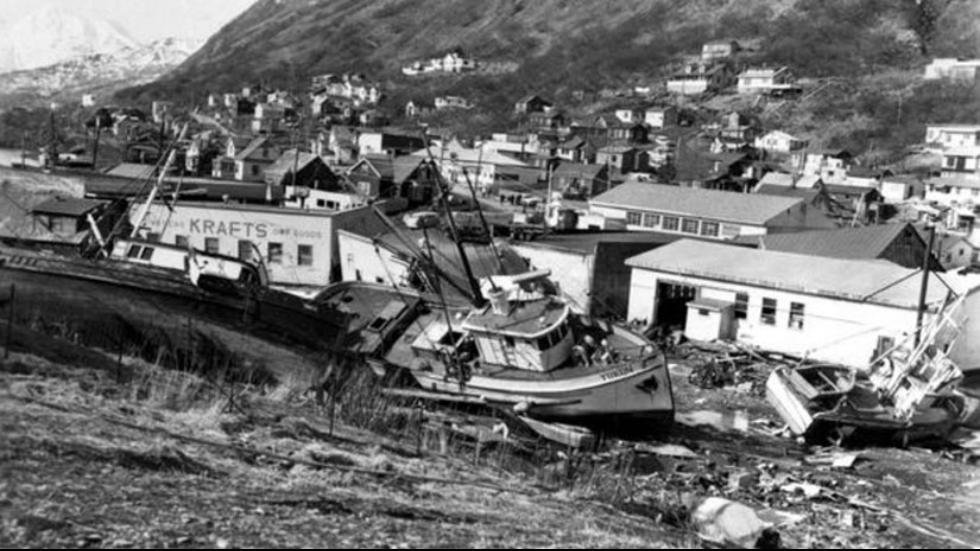
Using modern technology to map the floor of Prince William Sound, scientists from the U.S. Geological Survey and other organizations have found the landslide behind the tsunamis that killed about a third of the people in the Alutiiq village of Chenega, the service said on Monday.
Twenty-three of the village's 75 residents perished within minutes of the magnitude-9.2 earthquake that struck in 1964, making Chenega one of the communities hardest hit by the event. The village was nearly leveled and later rebuilt at a different site with a slightly different name, Chenega Bay.
In the immediate aftermath of the earthquake, scientists speculated that underwater landslides produced the waves that struck Chenega, the USGS said. A USGS technical report on the earthquake that was published in 1969 cited "localized waves of unknown origin" as the source of the most destruction. "The local waves, and combinations of local waves and subaqueous slides, caused most of the earthquake related fatalities in Alaska," that report said.
But the bathymetric technology of the time allowed for study of the seafloor only to the depth of about 180 meters, or 330 feet, the USGS said. Modern surveys conducted with multibeam sonar technology and a seismic-reflection system revealed a big complex of underwater slides that had occurred at much lower depths, the USGS said.
The findings of the USGS-led project are described in a study published online in the journal Earth and Planetary Science Letters.
"What makes this slide unusual is that much of the material that slid was at a water depth of 250 to 350 meters," or 820 to 1150 feet, Peter Haeussler, a USGS geologist based in Anchorage and a co-author of the study, said in a statement released by the survey. "The deeper initiation depth made it particularly good at generating a tsunami."
The seafloor in that part of the sound was complex, with a big underwater moraine left as the remnant of a past glacier. Analysis of the new data showed the earthquake triggered glacial sediment to pour over that underwater moraine and blanket an area about 465 meters deep with a layer of debris that was, on average, 11 meters thick, the study said.
That volume of debris dumped on such a deep area would have sent a huge wave into Chenega four minutes after the shaking began -- a reconstruction of events that matched what actually happened to the village, the study said.
The findings confirm scientists' theories from the 1960s about the cause of the tsunamis, said Leslie Gordon, a USGS public affairs specialist in California.
"They really suspected that it was a landslide, but there was no way to document it and visualize it," she said. "It took 50 years to do that."
The findings also provide warnings about future quake-triggered underwater landslides, she said. Given certain seafloor conditions and contours, an earthquake need not be high in magnitude to cause a devastating localized tsunami, she said.
The lead author of the study is Daniel Brothers, a research geophysicist at the USGS's Pacific Coast and Marine Science Center. Along with Haeussler and others from the USGS, scientists from Boise State University and the Alaska Department of Fish and Game were co-authors of the study.



"But the bathymetric technology of the time allowed for study of the seafloor only to the depth of about 180 meters, or 330 feet, the USGS said."
180m = 590.55'
330' = 100m
Thus, I very strongly suspect the 180m is the typo, and should be 100m, and the 330' figure is the correct one, from the additional info further down a wee bit: "Analysis of the new data showed the earthquake triggered glacial sediment to pour over that underwater moraine and blanket an area about 465 meters deep with a layer of debris that was, on average, 11 meters thick, the study said."
The Alaska Dispatch needs a new proof reader who understands math and/or the metric/standard conversions. Or better yet, how about North America dropping that antiquated 'standard' system, and joining the rest of the civilized world and begin employing the much simpler and more precise metric system?
(What? North America 1.) admitting it is wrong, or 2.) 'joining the rest of the civilized world'? Never!)